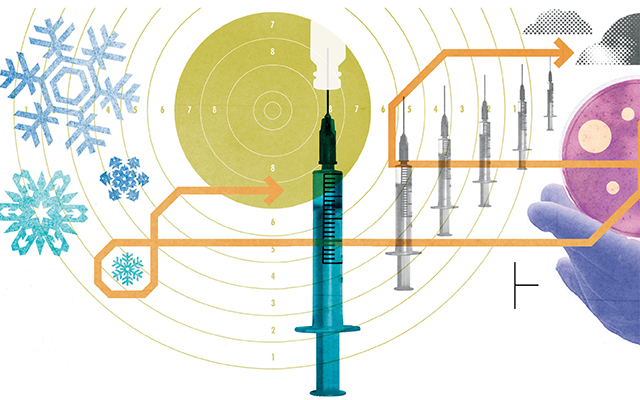During the 2017–2018 flu season, the Centers for Disease Control estimated influenza infected 48.8 million people and caused more than 79,400 deaths in the United States. It was one of the worst outbreaks since 2009. Hospitalization rates were high in all age groups — not just the very young and elderly, which is typical.
Yet flu shots are still a subject of controversy. Last year, vaccine coverage for adults was the lowest it’s been in seven seasons, with only slightly more than a quarter of people between 18 and 49 receiving a flu shot. Vaccination rates were up in 2018 compared with 2017, but it’s too early in the current season to tell whether more people will be vaccinated overall before peak flu season ends in March.
Here’s what you need to know about the flu vaccine, including why some of us are reluctant to get one, what the pros and cons are, and other steps you can take to keep yourself healthy during this flu season.
Who should get a flu shot?
U.S. vaccine policy has cast an ever-widening net on who should receive the vaccine. The shot was once recommended only for high-risk persons (including young children, pregnant women, and those with weakened immune systems or chronic illnesses) and people over age 50. But since February 2010, the CDC has advised that everyone over six months get a flu shot. This broader recommendation was implemented after the 2009–2010 flu season in an effort to emphasize the value of protecting adults between 18 to 49 years of age, who were particularly hard hit by the 2009 outbreak.
This is a different approach than in Europe and Australia, where healthy adults aren’t encouraged to get vaccinated. “In the U.S., influenza is viewed as a potentially deadly disease, whereas in the U.K. and much of Europe it is considered to be a bit of a nuisance that will generally pass with some bed-rest and plenty of hot soup,” says Jeremy Brown, MD, author of Influenza: The Hundred Year Hunt to Cure the Deadliest Disease in History. “Both descriptions are of course accurate — it’s just a matter of where you place the emphasis.”
Brown, an emergency-room physician and director of the Office of Emergency Care Research at the National Institutes of Health (who says his views do not necessarily represent those of the NIH or the federal government), asserts there is no question that high-risk groups should be vaccinated. “That group includes children, the elderly, those with chronic lung diseases or weakened immune systems, those living in residential care, . . . pregnant women, . . . [and] those who take care of high-risk groups, such as healthcare workers. But if you are an otherwise healthy adult, the best evidence we have is that the additional benefit of the flu vaccine is minimal.” And with that, he says, you should discuss your options with your doctor.
Edward Belongia, MD, director of the Center for Clinical Epidemiology and Population Health at the Marshfield Clinic Research Institute in Wisconsin, explains that the main justification to vaccinate all children is to protect both the children and the older population, who are hit hardest by influenza. “[Children] are the source for those infections. Vaccinating kids helps older adults.” Likewise, if you are someone who is around young children, you might consider extra precautions to protect yourself during flu season.
How effective is the flu vaccine from year to year?
In a good year, when the strains are well matched to the vaccine and mutations to the virus are minimal, effectiveness ranges between 40 and 60 percent. In a bad year the shot might work only about 10 percent of the time. In the last 15 years, efficacy has dipped below 40 percent in four seasons: 2004–2005, 2005–2006, 2007–2008, and 2014–1015.
Our immune system plays a role in efficacy too. “The immune response is such that the durability of the vaccine wanes quickly,” explains Michael T. Osterholm, PhD, MPH, director of the Center for Infection Disease Research and Policy. “There’s a 20 percent loss of protection per month after being vaccinated.”
Although the CDC recommends vaccination by the end of October, they still encourage vaccination throughout the flu season.
Most influenza experts contend that some protection is better than nothing when it comes to influenza, an illness that can be unpredictably severe. “Because influenza is a common disease, people fail to appreciate how bad it can be unless a friend or family member becomes hospitalized or dies,” says Belongia. “The vaccine we have provides moderate protection in most seasons, and is always better than not getting vaccinated.”
Why is it so hard to match the vaccine to the circulating virus?
The flu isn’t like most vaccine-preventable illnesses. Childhood vaccinations have more than a 90 percent success rate. In some cases, it’s 100 percent. That’s because those viruses don’t mutate. Influenza viruses change year to year, which is why the World Health Organization follows influenza surveillance worldwide, all year, to pinpoint which variants of the strains will become pervasive.
After they make recommendations in February, manufacturers begin production of the vaccines, which include either three or four of the predicted strains and will hit the market about six months later. “The strains included in the vaccine account for 99.99 percent of all flu out there,” says Osterholm.
But even pinpointing the right strain can’t prevent the virus from further shape-shifting during that short production period. Sometimes one or more viruses can mutate just enough that the immune system no longer recognizes them.
What vaccines are available for the 2018–2019 Flu Season?
Most flu shots contain four influenza strains: two A strains (H1N1 and H3N2) and two B strains. For the 2018–2019 season, the H3N2 strain is predicted to cause the most illness. This strain has been troublesome in the past, in part because it mutates faster than H1N1 and B viruses. It also grows poorly in chicken eggs, which is the primary vaccine-manufacturing method, making it more difficult to protect against.
In 2016, the FDA approved Flucelvax, the only cell-based flu vaccine licensed in the United States. Although it’s new for the flu, cell-culture technology is used to produce vaccines for rotavirus, polio, smallpox, hepatitis, rubella, and chickenpox.The CDC says it has “the potential to offer better protection than traditional, egg-based flu vaccines as a result of being more similar to flu viruses in circulation.” The technology prevents egg-adapted changes that can lower the immunity response to the vaccine. Likewise, a new recombinant flu vaccine, called Flublok Quadrivalent, doesn’t require eggs for production at all and can be produced faster — an important advantage during a pandemic or vaccine supply shortage.
The nasal spray vaccine (also known as the “live attenuated influenza vaccine” or FluMist) is back for this flu season after a hiatus when it showed a lack of effectiveness against the H1N1 virus between 2011 and 2017. It now has a new H1N1 component, which is especially good news for children who don’t like needles. Research conducted before 2011 showed an efficacy as high as 83 percent for children from 6 months to 7 years old (though rates are not as high for adults, and the nasal-spray vaccine is not currently recommended for children under two years old). Although there are restrictions on who can receive the LAIV, exposure to this weakened live virus could potentially prime the body with a more durable immunity.
Here is a list of all flu vaccines approved for use in the United States for the 2018–2019 flu season:
https://www.cdc.gov/flu/professionals/acip/2018-2019/2018-19summary.htm#iivs
If I’m healthy, won’t my own immune system fend off the flu?
Even if you decline immunization and get sick with manageable flu symptoms, the virus is highly contagious, and you can pass it to others before you’re symptomatic. So, while it might not hospitalize you, you stand a good chance of infecting someone whose immune system is more vulnerable. “A goal of the vaccine is to reduce transmission,” Belongia says. “Not just to protect yourself, but people around you.”
Also, even if you catch the flu and fend it off, you’re at risk for coming into contact with another strain that your system won’t be protected against. “The yearly influenza vaccine contains several different strains of the virus, allowing your body to develop an immunity to each of them,” Brown explains. “But if you caught influenza and became immune, you would only be immune to the single strain of the disease that you contracted.”
Lastly, adds Brown, disease exposure can result in greater immunity in some instances, “but this comes at the risk of the complications that are associated with a natural infection.” The most serious complications from the flu include pneumonia, sepsis, inflammation of the heart, and respiratory failure.
Can the flu shot make me less sick even if I do get the flu?
If you get vaccinated and still get the flu, you are less likely to need outpatient treatment or hospitalization in the case of a more serious illness.
According to Belongia, getting a shot won’t necessarily result in milder symptoms in a more typical flu season. However, he says, the most important benefit of the influenza vaccine isn’t preventing the flu altogether, but preventing hospitalization — namely, keeping people out of the ICU and off life support. “The vaccine is effective for reducing the burden of hospitalization and death, and that is especially important during a severe season.”
Can the flu vaccine cause the flu in some people?
The vaccine itself will not give anyone the flu. Some people report fever, fatigue, or muscle aches after getting a flu shot, which could be a result of the body’s immune response kicking in. It’s kind of like putting yourself through a tough workout: Your body feels sore because your muscles are getting stronger.
You could also get sick with a flulike illness, one of some 200 viruses that won’t respond to vaccination but can cause similar symptoms. If you get the shot and still get sick, you might have caught one of those other viruses in circulation.
Your illness could also be the result of a poorly timed shot. Because it takes up to two weeks after vaccination to be protected against the flu, someone could coincidentally get the virus before the vaccine starts working.
How concerned should I be about additives in the flu vaccine?
“We have a thorough understanding of what’s in this vaccine,” Belongia says. Still, some are dubious about certain ingredients, such as formaldehyde, which is used in the production to inactivate the virus and then removed, leaving a trace amount behind. Thimerosal, a preservative that contains a type of mercury, is also present at nontoxic levels, but only in multiuse vials to prevent bacteria and fungi from contaminating the vial between doses. Other ingredients in the flu vaccine include stabilizers, emulsifiers, and antibiotics, which have been tested for safety. If you’re concerned about Thimerosal, ask your doctor for a preservative-free option.
“The only systemic adverse effects of vaccine ingredients that have been documented have been allergic reactions among individuals who are allergic to a specific ingredient,” explains Frank DeStefano, MD, Director of the CDC’s Immunization Safety Office. “Other than allergic reactions and transient local reactions, such as swelling or redness at the injection site, no adverse reactions have been documented to be caused by any vaccine ingredients.” DeStefano adds that like all vaccines, influenza vaccines and their component ingredients are rigorously tested by the Food and Drug Administration before they are approved for licensure.
“Its safety is not taken for granted,” Belongia says. “Every year we monitor safety of the flu vaccine in near real time by looking at potential issues to see if any problems happen with greater frequency than what would occur by chance.”
What’s up with the universal flu vaccine?
The goal of a universal vaccine is to cover all possible strains of influenza. “The most important project in vaccine research is the development of a universal flu vaccine,” says Brown. “This would target a part of the influenza virus that does not mutate, and so might only need to be given once in a lifetime rather than each year.”
With a growing understanding for our risk of another pandemic and a drive to develop better protection for the seasonal vaccine, Belongia says, government and industry are providing more funding to get closer to a universal vaccine. In February 2018 the National Institutes of Allergy and Infectious Disease announced that it is making universal-flu-vaccine development a priority and published a strategic plan for research efforts. The Bill and Melinda Gates Foundation is backing a “Universal Influenza Vaccine Development Grand Challenge.” And new legislation introduced in 2018 calls for a $200 million-a-year investment for universal-flu-vaccine development for the NIH through 2023.
But how soon such a vaccine will become available is still hard to say. Given the challenges and length of time needed to do studies to prove a vaccine works at a level of licensure, Belongia says, the universal vaccine is still at least a decade in the making: “Every five years someone says we’re five years away.”
If I choose not to get vaccinated, what else can I do to stay healthy during flu season?
Your immune system needs good working conditions to fight off influenza or any contagious illness: plenty of sleep, daily exercise, nutritious food, and low stress. Good hygiene also goes a long way to minimize your risk and keep the spread of illness to a minimum. Don’t underestimate these commonsense practices:
- Avoid close contact with sick people whenever possible.
- When you are ill, stay home in consideration for others. Urge your friends, family, and coworkers to do the same.
- During flu season, wash your hands frequently to protect yourself and others from germs.
- Cover your mouth and nose with a tissue when coughing or sneezing. (If you don’t have a tissue, cough or sneeze into your elbow or upper arm — not your hands.)
- Keep your hands away from your face. Germs routinely spread when a person touches something contaminated with germs and then touches his or her eyes, nose, or mouth.
See “10 Tips to Prevent the Flu” for more advice on staying healthy this season.




This Post Has 0 Comments